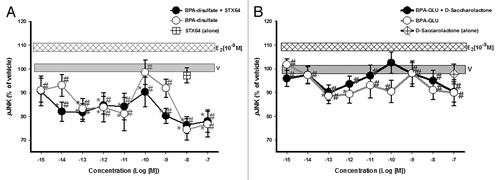Figures & data
Figure 1. Structure of BPA, its variably chlorinated versions, and BPA phase II metabolites. (A) Bisphenol A; (B) Mono-, (C) Di-, and (D) Tri-chlorobisphenol A; (E) Bisphenol A β-d-glucuronide; (F) Bisphenol A disulfate.
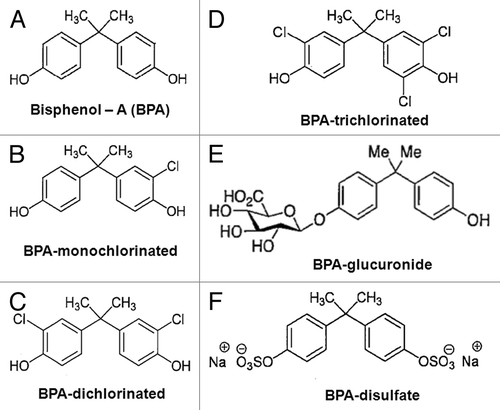
Figure 2. Dose-response analysis of ERK phosphorylation (pERK) in GH3/B6/F10 cells after exposure to BPA and its progressively chlorinated versions. The cells were exposed to a range of concentrations (in log increments) of (A) BPA, (B) mono-, (C) di-, and (D) tri-chlorinated BPA. pERK was measured by plate immunoassay at a 5 min exposure time. The widths of the vehicle and E2 (10−9M) bars represent the means ± SE (n = 24 over three experiments) * = p < 0.05 when compared with vehicle (V). # = p < 0.05 when compared with 10−9M E2. E2 (10−9M) is significantly different from vehicle.
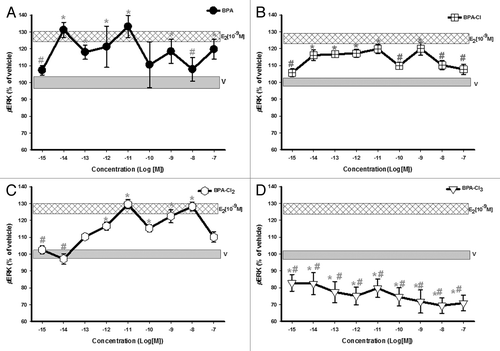
Figure 3. Dose-response analysis of JNK phospho-activation (pJNK) in response to varying concentrations of BPA and its progressively chlorinated versions. GH3/B6/F10 cells were exposed to increasing concentrations (in log increments) of (A) BPA, (B) mono-, (C) di-, and (D) tri-chlorinated BPA. pJNK was measured by plate immunoassay at a 5 min exposure time. The widths of the vehicle and E2 (10−9M) bars represent the means ± SE (n = 24 over three experiments) * = p < 0.05 when compared with vehicle (V). # = p < 0.05 when compared with 10−9M E2. E2 (10−9M) is significantly different from vehicle.
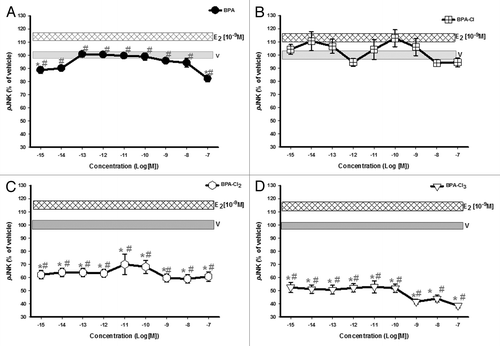
Figure 4. Dose-response analysis of ERK phospho-activation (pERK) by BPA phase II metabolites. GH3/B6/F10 cells were exposed to increasing concentrations (in log increments) of (A) Bisphenol A- disulfate and (B) Bisphenol A β-d-glucuronide. The cells were pre-incubated ± D-glucaric acid-1,4-lactone (20 mM) or STX-64 (10 nM) to inhibit β-glucuronidase and sulfatase, respectively. pERK was measured by plate immunoassay at a 5 min exposure time. Controls for the inhibitor administered alone are shown by a symbol at the single concentration at which it was used. The widths of the vehicle and E2 (10−9M) bars represent the means ± SE (n = 24 over three experiments) * = p < 0.05 when compared with vehicle (V). # = p < 0.05 when compared with 10−9M E2. E2 (10−9M) is significantly different from vehicle.
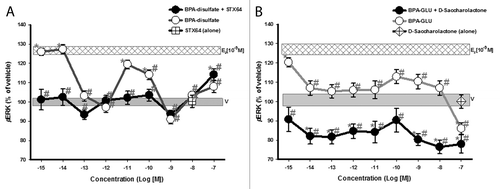
Figure 5. Dose-response analysis of JNK phospho-activation (pJNK) by BPA phase II metabolites. GH3/B6/F10 cells were exposed to increasing concentrations (in log increments) of (A) Bisphenol A-disulfate and (B) Bisphenol A β-d-glucuronide. The cells were pre-incubated ± D-glucaric acid-1,4-lactone or STX-64 to inhibit β-glucuronidase and sulfatase, respectively, prior to analysis. Controls for the inhibitor administered alone are shown by a symbol at the single concentration at which it was used . pJNK was measured by plate immunoassay at a 5 min exposure time. The widths of the vehicle and E2 (10−9M) bars represent the means ± SE (n = 24 over three experiments) * = p < 0.05 when compared with vehicle (V). # = p < 0.05 when compared with 10−9M E2. E2 (10−9M) is significantly different from vehicle.
